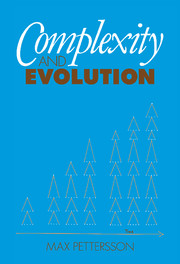Book contents
- Frontmatter
- Contents
- Foreword by Joseph Needham, FRS
- Preface
- Acknowledgements
- 1 Natural and other hierarchies
- 2 Major integrative levels
- 3 Some logarithmic forms of display
- 4 Physical range of integrated natural entities
- 5 Biological range of integrated natural entities (first part)
- 6 Biological range of integrated natural entities (second part)
- 7 Social range of integrated natural entities
- 8 Human societies (first part)
- 9 Human societies (second part)
- 10 Acceleration in evolution
- 11 Further allied accelerations
- 12 Aspects of number
- 13 Aspects of mass
- 14 Positive skewness
- 15 Quantitative conclusions
- Bibliography
- Index
15 - Quantitative conclusions
Published online by Cambridge University Press: 18 January 2010
- Frontmatter
- Contents
- Foreword by Joseph Needham, FRS
- Preface
- Acknowledgements
- 1 Natural and other hierarchies
- 2 Major integrative levels
- 3 Some logarithmic forms of display
- 4 Physical range of integrated natural entities
- 5 Biological range of integrated natural entities (first part)
- 6 Biological range of integrated natural entities (second part)
- 7 Social range of integrated natural entities
- 8 Human societies (first part)
- 9 Human societies (second part)
- 10 Acceleration in evolution
- 11 Further allied accelerations
- 12 Aspects of number
- 13 Aspects of mass
- 14 Positive skewness
- 15 Quantitative conclusions
- Bibliography
- Index
Summary
It now seems appropriate to review the main quantitative conclusions of the foregoing chapters. Most of the conclusions involve entities of all three ranges, the physical, the biological and the social. The conclusions will be listed according to chapter of origin, and the relevant figures and tables will be mentioned to facilitate reference back.
Major integrative levels (Chapter 2)
By making use of the compositional criterion and the duality criterion, it is found that the number of major integrative levels – into which the integrated natural entities around us can be grouped – is no more nor less than nine. There are three levels in the physical range, three in the biological range and three in the social range (Table 2.2, Fig. 1.3, and for the duality criterion Fig. 2.1 and Fig. 2.2).
Acceleration in evolution (Chapter 10)
The period of time before entities of a higher integrative level have emerged from the biological or social level below has, in general, decreased with the advance of time (Fig. 10.1).
When the estimated mass of innovatory entities is considered, they are found to form an exponential series, or at times to increase faster than in a simple exponential manner. The doubling time has decreased from about 75 million years, down to about 12 million years (Fig. 10.4).
Further accelerations (Chapter 11)
The increasing numbers of people in the world is found, numerically, to approximately continue the same acceleratory trend as evinced by the earlier evolutionary acceleration (Fig. 11.1).
Information
- Type
- Chapter
- Information
- Complexity and Evolution , pp. 131 - 134Publisher: Cambridge University PressPrint publication year: 1996
